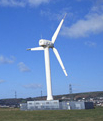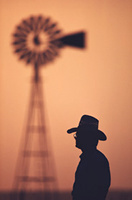 |
A wind turbine converts the energy in moving air into
usable energy. It is basically just a sophisticated version of a windmill.
It’s a series of fan blades, arrayed around a shaft that turns a
generator. |
History
After the early successes of waterwheels, windmills became
another popular method of harnessing the power of nature to replace the work
being done by human and animal muscle. It was used to grind grain, pump water,
press oil, power boats, saw lumber and make paper.
The first wind mechanism was developed in the first century
A.D., and was modeled after a water-wheel. The use of wind to grind grain
(milling) really started to develop in the 7th Century is Islamic countries,
with the mention of Persian millwrights from as early as AD 644. These mills
(on what would now be called the border between Iran and Afghanistan), had
fixed paddles attached to a vertical shaft with the millstones directly beneath.
These types of windmills spread to Western Europe by the 11th Century and
all the way to China by the 13th Century.
| By the 17th Century, windmills had become the main prime
mover in the Netherlands, which used them to become the most industrialized
country in the world. The transition from wind to steam took place slowly
in the low countries – the Zaan district of the Netherlands had over
900 corn mills as late as the 19th Century. |
 |
 |
Steam power quickly replaced wind and water in most developed
countries, however in remote areas (especially in the newly settled countries
like Canada, the United States, Australia, New Zealand and the West Indies),
wind remained an important energy source. In 1883, American Stewart Parry
began making steel wind pumps with metal vanes, and this design quickly
spread around the world. While relatively inefficient, these devices are
rugged and reliable, and can pump small amounts of water without much
attention or maintenance. |
Basic Design
As the wind passes over the rotor blades, the shape of the blades causes differences
in pressure on the two sides of the blade surface. As a result of the pressure
difference the blade moves and imparts a spin to the blade shaft. The rotating
blade shaft is connected to the shaft of the generator through a gearbox that
increases the rotational velocity. The generator shaft then spins the rotor
of the generator through the magnetic field caused by the stator and electric
power is generated. The power in the wind has been converted into electric
power.
The most important factor in designing and locating wind turbines,
is wind velocity. The power content of the wind varies with the cube of the
wind velocity. So if the wind is twice as fast, it will be eight times more
powerful (2 x 2 x 2 = 8).
That covers the most common prime movers found in the powerhouse.
Let’s stop for a recap. |